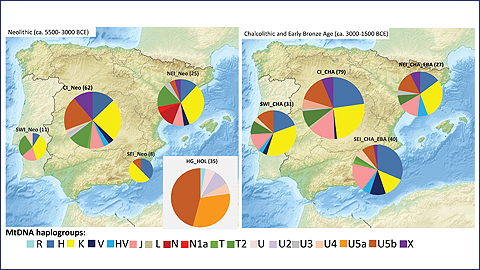Local and migrant populations mixed intensively in the Iberian Peninsula since the Early Neolithic
UAB Prehistory researchers participated in a study which points to a quicker than previously thought mixture between and integration of local hunter-gatherers and newly arrived farmers from the Middle East. The study verifies an intense and complex interaction of ancient DNA lineage circa 5500 to 4500 BCE.

Highly intense genetic interactions
The results now appearing in Scientific Reports of Nature include the mtDNA identification from 213 newly analysed and 125 already published individuals from present day Spain and Portugal. Different from the situation observed during the early and middle Neolithic of Central and Southeast Europe, the populations of the Iberian Peninsula show a much more complex and intense interaction between local hunter-gatherers and the newly arrived Neolithic populations of Near Eastern origin. A strong mixture of female DNA lines of ancestry of different origins is already observed during the Early Neolithic (c. 5500-4500 BCE), when the survival of hunter-gatherer linages seems to have been marginal in central and South-eastern Europe. Instead, in Iberia, the share of mtDNA haplogroups related to hunter-gatherers increases steadily in relation to the distance from the Mediterranean coast. The diverse new haplogroups of Eastern origin are found mixed with local hunter-gatherers. “However, we also observe the arrival of Neolithic communities related to the Central European farmers (so called LBK groups – cast: grupos de ceramica de bandas) in the northeast of Iberia, particularly in the funerary cave site of Es Trocs, in the central Pyrenees” points out Kurt W. Alt of the Danube Private University in Krems, Austria, and initiator of the project.
The diversity of female lines of ancestry continues during the Copper Age, when populations became more homogenous. “This suggests a higher mobility and intermixture in different geographical regions” comments archaeo-anthropologist Cristina Rihuete-Herrada of the Universitat Autònoma de Barcelona. A particular case is the identification of an individual belonging to the L1b haplogroup at the site Camino de Las Yeseras, near Madrid. This group is most frequent in today’s West-Central Africa, and hints at a connection to the North-West African coasts in prehistoric times. “Iberia was a melting pot of influences and populations at the western end of the Mediterranean” concludes Manolo Rojo, of the University of Valladolid.
Although the sample size is still limited during the Bronze Age, the arrival of the eastern European steppes, identified in Central Europe during the 3rd millennium BCE, does not (yet) appear in the gene pool of the Iberian Peninsula. “So far we do not know when these populations from the north Pontic region might have arrived in Iberia and if they have anything to do with the rise of El Argar (2200-1550 cal BCE), the first state or state-like society of the western Mediterraean” indicates Roberto Risch of the Autonomous University of Barcelona.
The results now published point towards a slightly faster merging and integration of local hunter-gatherers and Neolithic migrants from the Near East. But many questions still remain. “The close interrelation between genetic and cultural processes at the social level requires more archaeo-genetic analyses” reminds Anna Szécsényi-Nagy of the Hungarian Academy of Sciences in Budapest, indicating the need to continue investigating in this direction. “The perspectives are promising, as the present project has managed to recover aDNA information even from human remains of southern Spain, where climatic conditions are not favourable for this type of material” adds Cristina Rihuete-Herrada. The nuclear DNA of selected, well preserved samples of this project have already been analysed and published (see Haak et al. 2015; Mathieson et al 2015). A genome-wide comparison of the three mentioned European regions has been presented parallel to the present paper, in close collaboration with the Department of Genetics of the Harvard School of Medicine and the Max Planck Institut for the Science of Human History in Jena (Lipson et al. 2017). “The early farmers of Iberia, Germany and Hungary are nearly identical genetically, suggesting that they had a common origin in the Near East”, emphasised Wolfgang Haak of the Max-Plank Institute already two years ago.
Original article:
“The maternal genetic make-up of the Iberian Peninsula between the Neolithic and the Early Bronze Age”. https://www.nature.com/articles/s41598-017-15480-9
Images:
MtDNA haplogroup composition of prehistoric groups. Each colour represents a different female DNA line. The diversity of colours is an indicator of the divers origins of the population.
Abbreviations: Hunter-gatherers in Iberia (HG_I), northeast Iberian Neolithic (NEI_Neo), Northeast Iberian Chalcolithic and Early Bronze Age (NEI_CHA_EBA), Neolithic in the Middle Ebro Valley and north Iberia (MEV_Neo), Central Iberian Neolithic (CI_Neo), Central Iberian Chalcolithic (CI_CHA), southwest Iberian Neolithic (SWI_Neo), southwest Iberian Chalcolithic (SWI_CHA), southeast Iberian Neolithic, Chalcolithic and Bronze Age (SEI_Neo_CHA_EBA).
Anthroplogical sampling and prehistoric chronological phases studied in the Iberian Peninsula.
El Argar Tomb BA-33 of the Bronze Age hill-top settlement of La Bastida (Murcia) dated around 1900-1800 BCE (© ASME-UAB).